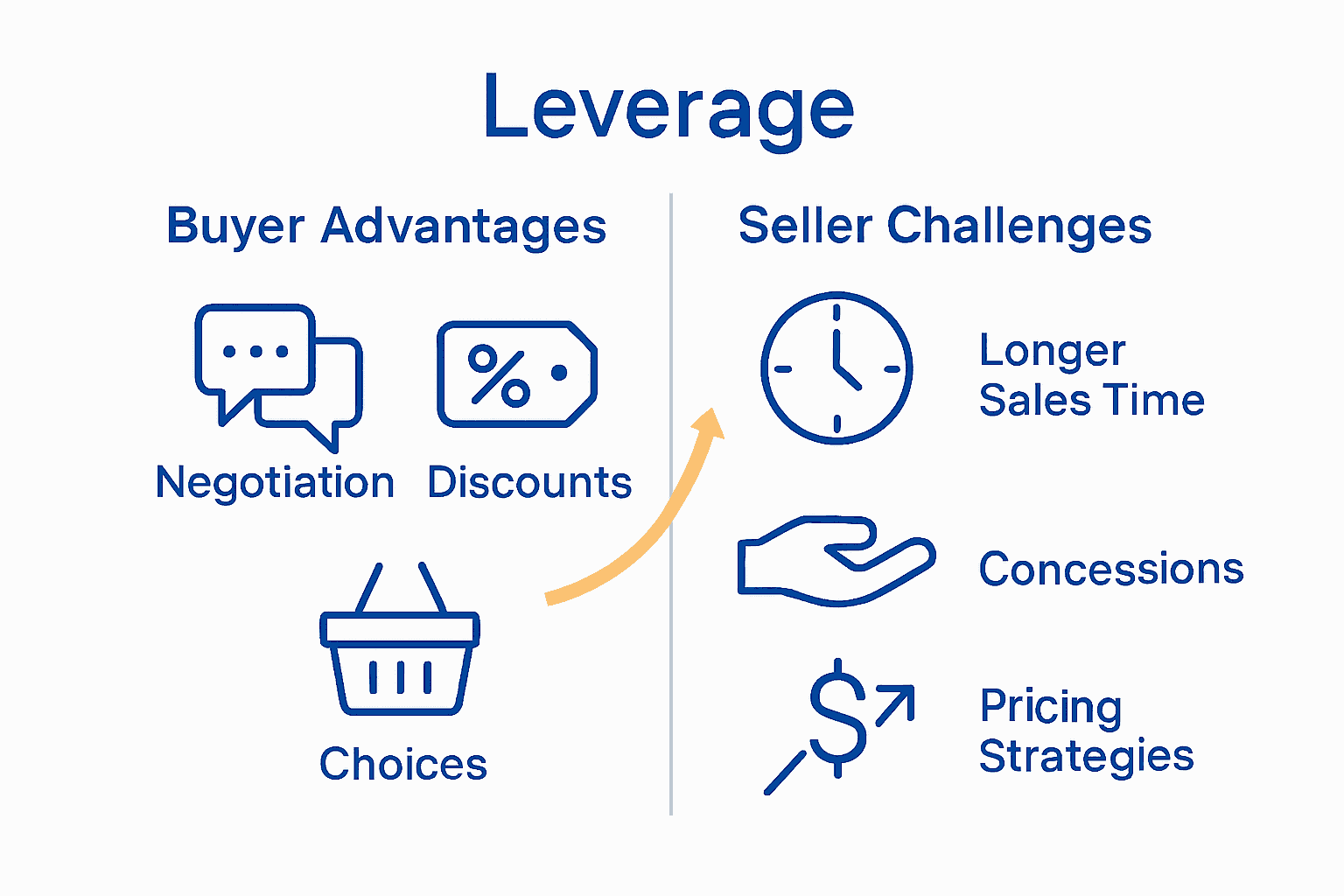What Is a Buyer’s Market? Complete Real Estate Guide

Over half of all real estate transactions in the past five years have occurred during a buyer’s market. This shift in power gives buyers stronger negotiating ability, more choices, and many chances to save money. With more homes available and sellers eager to close deals, understanding how a buyer’s market works can help you make smarter decisions whether you want a family home or an investment property.
Table of Contents
- Buyer’s Market Defined And Core Concepts
- How A Buyer’s Market Develops Locally
- Key Signs And Features Buyers Should Know
- Pros And Cons For Buyers And Sellers
- Navigating Offers And Negotiations Successfully
Key Takeaways
| Point | Details |
|---|---|
| 1. Buyer’s Market Characteristics | A buyer’s market occurs when housing inventory is high, prices are lower, and buyers gain stronger negotiation leverage due to reduced competition. |
| 2. Economic Influences | Employment rates, interest trends, and local economic conditions all shape whether a region transitions into a buyer’s or seller’s market. |
| 3. Negotiation Strategies | Buyers can maximize opportunities by making lower initial offers, negotiating closing costs, and requesting flexible seller terms or contingencies. |
| 4. Real Estate Dynamics | Each local market behaves differently. Understanding regional data in areas like Farmington Hills, Novi, and Oakland County helps buyers act strategically. |
Table: Key insights into buyer’s market conditions and how local economic and real estate factors in Oakland County influence negotiation power and pricing strategies.
Buyer’s Market Defined And Core Concepts
In the real estate landscape, a buyer’s market represents a unique economic environment where home buyers gain significant strategic advantages. According to saylor.org, a buyer’s market is characterized by an abundance of products, low prices, and customers having the power to dictate sale terms - a scenario arising when housing supply substantially exceeds demand.
The core characteristics of a buyer’s market include several critical elements that make it particularly attractive for potential homeowners:

- Increased Housing Inventory: More homes available on the market compared to interested buyers
- Lower Property Prices: Sellers must compete to attract limited buyers, driving prices down
- Negotiation Power: Buyers can request more contingencies, repairs, and favorable contract terms
- Extended Time on Market: Properties remain unsold for longer periods, creating opportunities for strategic purchases
In Oakland County’s real estate ecosystem, identifying a buyer’s market requires understanding nuanced local market dynamics. While docs.mbaresearch.org defines a buyer’s market as “the best time for consumers to buy, characterized by large supply, small demand, and low prices”, local factors like school districts, neighborhood amenities, and economic conditions also play significant roles in determining market conditions.
For homebuyers in Farmington Hills, Novi, and Northville, recognizing a buyer’s market means understanding that the traditional power dynamic between sellers and buyers has shifted. During these periods, buyers can afford to be more selective, negotiate more aggressively, and potentially secure properties at more favorable prices and terms. Smart buyers leverage these market conditions to make strategic real estate investments that align with their long-term housing goals.
How A Buyer’s Market Develops Locally
In Oakland County’s dynamic real estate landscape, the development of a buyer’s market is a complex interplay of multiple economic and local factors. According to fao.org, local buyer’s markets emerge when supply fundamentally outpaces demand, creating conditions that lead to lower prices and increased buyer leverage. This phenomenon doesn’t happen overnight but evolves through strategic shifts in local economic dynamics.
The key factors contributing to a local buyer’s market include:
- Economic Employment Trends: Job market fluctuations affecting housing demand
- Population Migration: Shifts in local population growth or decline
- New Housing Development: Increased construction of residential properties
- Interest Rate Changes: Financial conditions impacting mortgage affordability
- Local Industry Performance: Economic health of primary employment sectors
Diamondcu.org highlights that local buyer’s markets specifically develop through indicators like increased home inventory, properties lingering longer on the market, and gradually declining home prices. In Farmington Hills, Novi, and Northville, these conditions might manifest differently based on neighborhood-specific characteristics such as school district ratings, proximity to amenities, and local economic resilience.
For real estate investors and homebuyers in Oakland County, understanding these nuanced market development patterns is crucial. By monitoring local economic indicators, tracking housing inventory trends, and working with experienced Novi MI real estate professionals, buyers can strategically position themselves to capitalize on emerging buyer’s market conditions. The key is patience, thorough research, and a deep understanding of the local real estate ecosystem.
Key Signs And Features Buyers Should Know
Identifying a buyer’s market requires understanding specific indicators that signal shifting real estate dynamics. According to diamondcu.org, key signs include an increase in available housing inventory, properties remaining longer on the market, and a noticeable trend of declining home prices - all of which provide potential buyers with expanded options and enhanced negotiating leverage.
The most critical signs that distinguish a buyer’s market include:
- Extended Days on Market: Homes sitting unsold for 60-90 days or longer
- Price Reductions: Consistent downward price adjustments in neighborhood listings
- High Inventory Levels: Significantly more homes available compared to active buyers
- Seller Concessions: Increased willingness of sellers to offer closing cost assistance
- Lower Asking Prices: Initial listing prices below previous market valuations
Accountinginsights.org emphasizes that in a buyer’s market, sellers often become more flexible, frequently accepting offers below their initial asking price and offering additional concessions to secure a sale. For Oakland County homebuyers, this means opportunities to negotiate more favorable terms, request home repairs, or even ask for closing cost credits that might not be possible in a competitive seller’s market.
Navigating a buyer’s market successfully requires strategic preparation and working with experienced Michigan real estate experts who understand local market nuances. Buyers should conduct thorough research, get pre-approved for mortgages, and remain patient, knowing that market conditions favor their negotiating position. The key is to combine market awareness with careful financial planning to make the most of emerging buyer’s market opportunities.
Pros And Cons For Buyers And Sellers
In the intricate dance of real estate transactions, a buyer’s market creates a unique landscape with distinct advantages and challenges for both buyers and sellers in Oakland County. According to accountinginsights.org, buyers gain significant benefits including a wider selection of properties, reduced pressure to make rapid decisions, and substantially greater leverage during negotiations.
Buyer Advantages:
- Price Flexibility: Opportunity to purchase homes below market value
- Negotiation Power: More room to request repairs or closing cost credits
- Lower Competition: Fewer bidding wars and multiple offer scenarios
- Comprehensive Inspections: More time and willingness from sellers to address property concerns
- Better Mortgage Terms: Potential for more favorable lending conditions
Diamondcu.org highlights that buyers might secure superior properties at lower prices, especially when homes have lingered on the market. Conversely, sellers face more challenging conditions, often requiring strategic pricing and understanding move-in-ready home differences to attract potential buyers.
Seller Challenges and Strategies:
- Potentially longer time on market
- Need for more aggressive pricing strategies
- Higher likelihood of making concessions
- Greater emphasis on home presentation and marketing
- Increased importance of property condition and appeal
Successful navigation of a buyer’s market demands adaptability from both parties. Sellers must be prepared to be more flexible, while buyers should remain strategic, understanding that not every property represents an optimal investment, even in favorable market conditions.
Here’s a summary of advantages and challenges for both buyers and sellers in a buyer’s market:

| Aspect | Buyers Benefit | Sellers Challenge |
|---|---|---|
| 1. Price Flexibility | Buyers can often purchase below market value and negotiate better pricing. | Sellers may need to accept lower offers to stay competitive. |
| 2. Negotiation Power | Buyers can request seller credits, closing cost assistance, or repairs. | Sellers may need to offer concessions to secure a deal. |
| 3. Competition Level | Less buyer competition provides more leverage and choice. | Fewer interested buyers may slow down the selling process. |
| 4. Time Pressure | Buyers can take more time to make decisions without bidding pressure. | Homes may stay on the market longer before receiving offers. |
| 5. Home Condition | Buyers can request thorough inspections and necessary updates before closing. | Sellers may need to improve home presentation or invest in repairs to attract offers. |
Table: Comparison of buyer advantages and seller challenges during a buyer’s market in Oakland County, Michigan real estate.
Navigating Offers And Negotiations Successfully
In a buyer’s market, the negotiation landscape shifts dramatically, offering strategic opportunities for buyers willing to approach real estate transactions with careful planning and insight. According to accountinginsights.org, buyers gain substantial leverage, potentially securing lower purchase prices and favorable terms like seller-paid closing costs.
Key Negotiation Strategies:
- Initial Offer Pricing: Submit offers 5-10% below listing price
- Contingency Requests: Include comprehensive inspection and financing contingencies
- Repair Negotiations: Request significant repairs or closing cost credits
- Flexible Closing Dates: Accommodate seller’s preferred timeline
- Limited Earnest Money: Minimize upfront financial commitment
Diamondcu.org emphasizes that buyers can potentially purchase superior properties at reduced prices, especially when homes have remained unsold for extended periods. Successful negotiators understand that patience and strategic positioning are critical when navigating complex closing processes.
Ultimately, effective negotiation in a buyer’s market requires a delicate balance of assertiveness and empathy. Buyers should remain realistic about property values, conduct thorough market research, and approach negotiations with professionalism. The goal is not to exploit sellers, but to create a mutually beneficial transaction that reflects current market conditions while respecting the emotional and financial investment of all parties involved.
Take Advantage of Oakland County’s Buyer’s Market with Expert Guidance
Navigating a buyer’s market can be overwhelming when home prices are shifting and negotiation power lies with buyers. If you want to unlock the advantages of increased housing inventory and price flexibility without the stress, expert local support makes all the difference. Whether you’re in Farmington Hills, Novi, or Northville, identifying when to negotiate contingencies or request seller concessions requires insight into Oakland County’s unique market conditions.

Discover how Tom Gilliam’s 20 years of real estate experience helps you seize opportunities in this buyer’s market. From tailored pricing strategies to skilled negotiation and relocation assistance, Tom ensures you get the home you deserve at the best terms. Start your journey today with Farmington Hills homes for sale and Oakland County real estate services by Tom Gilliam and learn how to confidently navigate this buyer’s market. Visit Homes2MoveYou.com to explore your options and turn today’s market conditions to your advantage before competition rises again.
Frequently Asked Questions
What defines a buyer’s market in real estate?
A buyer’s market is characterized by an excess of housing inventory, leading to lower property prices and increased negotiating power for buyers. This scenario arises when the supply of homes significantly exceeds the demand.
What are key signs that indicate a buyer’s market?
Key signs of a buyer’s market include extended days on market for homes, price reductions in listings, high inventory levels, increased seller concessions, and lower asking prices compared to past valuations.
How can buyers take advantage of a buyer’s market?
Buyers can negotiate better prices, request more repairs or closing cost credits, and enjoy a wider selection of properties. With less pressure to make quick decisions, buyers can afford to be more selective.
What challenges do sellers face in a buyer’s market?
Sellers may encounter longer time on the market, a need for more aggressive pricing strategies, increased likelihood of making concessions, and the necessity for better home presentation and marketing to attract buyers.




